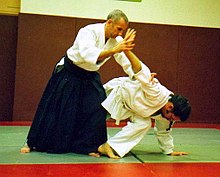Leverage (martial arts)
Levers are applications of the lever law in opponents in martial arts or in self-defense . The levers are reached with certain handles. They are particularly common in martial arts with full contact (e.g. judo and ju-jutsu ). Levers are part of grappling .
With a lever technique, limbs (extremities) are attacked; in detail, these are the joints of the upper extremities and the lower extremities (e.g. legs and knees) as well as shoulders, fingers, hands and feet.
Since joints cannot be loaded equally in all directions, this limit (“stop”) is used as an abutment . In addition, there are postures in which the opponent to whom the lever is applied has no way of applying his own muscle force against the lever. The limb to be levered is first brought into a suitable position in which it cannot be twisted out of the attacker's grip, and then loaded in a certain direction, which causes severe pain .
The aim of a lever is to cause it to fall or to fix. In order to use a lever, one must have control of the opponent's extremity in question.
Levers are often applied with one or both hands, and can also be created with the forearms or legs. Sometimes the trunk is used as a support. Leverage is usually carried out quickly so that the counterparty cannot take countermeasures.
Levers are not used with full force in practice fights. As soon as the lever works, it is customary to indicate the task by tapping ( Mairi ) on the floor or to the partner. If too much force is applied there is a risk of injury such as B. overextension of the ligaments or fracture of the joint. A severe injury can mean that the limb will no longer be resilient for life ( rubber joint ) or that diseases such as rheumatism and arthritis develop .
For this reason, not all levers are allowed in every sport. In judo, for example, only levers on the elbow joints are permitted nowadays, while in self-defense systems everything that is promising is used (e.g. neck lever).
Categories
There are the following ways to leverage and execute:
- Extension levers, in which an extended hinge joint (e.g. the elbow) is levered. The joint is levered here by overstretching.
- Flexion levers, in which a flexed hinge joint is levered.
- Rotary levers, in which a bent joint is rotated around the longitudinal axis of the part closer to the trunk. For example, with the elbow bent, the forearm can be gripped to rotate the upper arm around its longitudinal axis.
Examples
- Arm lever ( Armlock ) : Takes place either as an extension lever against the elbow (Armbar) or as a flexion lever against the shoulder ( Kimura , Omoplata ).
- Leg lever ( Leglock ) Either as an extension lever ( footlock ) or rotary lever ( Toe Hold ) against the foot, or as an extension lever ( Kneebar ) or rotary lever ( Heel Hook ) against the knee.
- Neck Lever ( Spinal Lock ): This is considered the most dangerous variant of a lever grip and is therefore mostly prohibited in sporting competitions.

